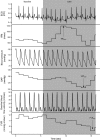Carotid sinus hypersensitivity: block of the sternocleidomastoid muscle does not affect responses to carotid sinus massage in healthy young adults
- PMID: 29038360
- PMCID: PMC5641935
- DOI: 10.14814/phy2.13448
Carotid sinus hypersensitivity: block of the sternocleidomastoid muscle does not affect responses to carotid sinus massage in healthy young adults
Abstract
The arterial baroreflex is crucial for short-term blood pressure control - abnormal baroreflex function predisposes to syncope and falling. Hypersensitive responses to carotid baroreflex stimulation using carotid sinus massage (CSM) are common in older adults and may be associated with syncope. The pathophysiology of this hypersensitivity is unknown, but chronic denervation of the sternocleidomastoid muscles is common in elderly patients with carotid sinus hypersensitivity (CSH), and is proposed to interfere with normal integration of afferent firing from the carotid baroreceptors with proprioceptive feedback from the sternocleidomastoids, producing large responses to CSM. We hypothesized that simulation of sternocleidomastoid "denervation" using pharmacological blockade would increase cardiovascular responses to CSM. Thirteen participants received supine and tilted CSM prior to intramuscular injections (6-8 mL distributed over four sites) of 2% lidocaine hydrochloride, and 0.9% saline (placebo) in contralateral sternocleidomastoid muscles. Muscle activation was recorded with electromyography (EMG) during maximal unilateral sternocleidomastoid contraction both pre- and postinjection. Supine and tilted CSM were repeated following injections and responses compared to preinjection. Following lidocaine injection, the muscle activation fell to 23 ± 0.04% of the preinjection value (P < 0.001), confirming neural block of the sternocleidomastoid muscles. Cardiac (RRI, RR interval), forearm vascular resistance (FVR), and systolic arterial pressure (SAP) responses to CSM did not increase after lidocaine injection in either supine or tilted positions (supine: ΔRRI -72 ± 31 ms, ΔSAP +2 ± 1 mmHg, ΔFVR +4 ± 4%; tilted: ΔRRI -20 ± 13 ms, ΔSAP +2 ± 2 mmHg, ΔFVR +2 ± 4%; all P > 0.05). Neural block of the sternocleidomastoid muscles does not increase cardiovascular responses to CSM. The pathophysiology of CSH remains unknown.
Keywords: Arterial baroreflex; carotid sinus hypersensitivity; sternocleidomastoid.
© 2017 The Authors. Physiological Reports published by Wiley Periodicals, Inc. on behalf of The Physiological Society and the American Physiological Society.
Figures




Similar articles
-
Arterial stiffness and the response to carotid sinus massage in older adults.Aging Clin Exp Res. 2010 Feb;22(1):36-41. doi: 10.3275/6810. Epub 2010 Feb 5. Aging Clin Exp Res. 2010. PMID: 20142630 Free PMC article.
-
Results of carotid sinus massage in a tertiary referral unit--is carotid sinus syndrome still relevant?Age Ageing. 2009 Nov;38(6):680-6. doi: 10.1093/ageing/afp160. Epub 2009 Sep 7. Age Ageing. 2009. PMID: 19736287
-
Assessment of a newly recognized association. Carotid sinus hypersensitivity and denervation of sternocleidomastoid muscles.Circulation. 1997 Jun 3;95(11):2548-51. doi: 10.1161/01.cir.95.11.2548. Circulation. 1997. PMID: 9184585
-
Alterations in reflex function contributing to syncope: orthostatic hypotension, carotid sinus hypersensitivity and drug-induced dysfunction.Herz. 1993 Jun;18(3):164-74. Herz. 1993. PMID: 8330851 Review.
-
At the heart of the arterial baroreflex: a physiological basis for a new classification of carotid sinus hypersensitivity.J Intern Med. 2013 Apr;273(4):345-58. doi: 10.1111/joim.12042. J Intern Med. 2013. PMID: 23510365 Review.
References
-
- Amin, V. , and Pavri B. B.. 2015. Carotid sinus syndrome. Cardiol. Rev. 23:130–134. - PubMed
-
- Blanc, J. J. , L'Heveder G., Mansourati J., Tea S. H., Guillo P., and Mabin D.. 1997. Assessment of a newly recognized association. Carotid sinus hypersensitivity and denervation of sternocleidomastoid muscles. Circulation 95:2548–2551. - PubMed
-
- Garmon, E. , and Dulebohn S.. 2017. Topical, Local, and Regional Anesthesia and Anesthetics. Available at: http://www.ncbi.nlm.nih.gov/pubmed/28613644 (Accessed June 21 2017).
-
- Guelen, I. , Westerhof B. E., van der Sar G. L., van Montfrans G. A., Kiemeneij F., Wesseling K. H., et al. 2008. Validation of brachial artery pressure reconstruction from finger arterial pressure. J. Hypertens. 26:1321–1327. - PubMed
MeSH terms
Substances
LinkOut - more resources
Full Text Sources
Other Literature Sources
Medical
Miscellaneous

